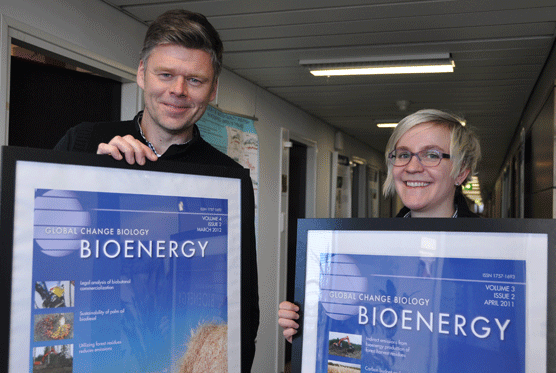Scientific articles on bioenergy written by Finnish researchers have gained exceptionally good visibility in the international science community. They are cited, downloaded and used extensively in, for example, the IPCC's new climate report, as a result of which they are influencing international bioenergy policy and the development of emission calculation schemes.

"Scientific work can be very influential and topical, even if it sometimes seems like people are not widely aware that it can have this kind of impact," says Research Professor Jari Liski, who is involved in bioenergy research at SYKE.
At SYKE, the publishing of peer-reviewed scientific papers is encouraged: "During the last two years, the number of scientific articles published has been higher than ever in the entire history of SYKE," rejoices Research Director Per Mickwitz.
Stump energy article among the top then most cited
For example the article "Indirect carbon dioxide emissions from producing bioenergy from forest harvest residues" published in 2010 was among the ten most cited articles published by the leading scientific journal Global Change Biology Bioenergy for three years following its publication.
Meanwhile the article "Sustainability of forest bioenergy in Europe: land-use-related carbon dioxide emissions of forest harvest residues", published a year ago, was among the 15 most downloaded articles last year. Both articles were the subjects of SYKE bulletins at the time of their publication.
Results quickly found their way to the IPCC report
"It is great to see how quickly research findings spread and reach new users, as wheels in the science world have traditionally been thought to turn slowly. For example, the results of our research ended up in the IPCC report in quite a short time," says researcher Anna Repo.
The third part of the IPCC's new assessment report, which focuses on mitigation of climate change, cites Finnish studies on numerous occasions:
page 81: "However, mitigating potential adverse side‐effects—such as the loss of soil C— associated to harvesting agriculture residues is more complex as they depend on the different crops, climate, and soil conditions (Kochsiek and Knops, 2012; Repo et al., 2012)."
page 89: "For example, in the specific case of existing forests that may continue to grow if not used for bioenergy, some studies employing counterfactual baselines show that forest bioenergy systems can temporarily have higher cumulative CO2 emissions than a fossil reference system (for a time period ranging from a few decades up to several centuries; (Repo et al., 2011; Mitchell et al., 2012; Pingoud et al., 2012; Bernier and Paré, 2013; Guest et al., 2013; Helin et al., 2013; Holtsmark, 2013)."
page 93: "In general, the use of easily decomposable residues and wastes for bioenergy can produce GHG benefits (Zanchi et al., 2012), similarly to increasing the biomass outtake from forests affected by high mortality rates (Lamers et al., 2013), whereas the removal of slowly decomposing residues reduces soil carbon accumulation at a site and results in net emissions (Repo et al., 2011)."
More information:
Research Professor Jari Liski, the Finnish Environment Institute, tel +358 (0)295 251 385, firstname.lastname@ymparisto.fi
Researcher Anna Repo, tel. +358 (0)295 251 555, firstname.lastname@ymparisto.fi
Repo, A., Böttcher, H., Kindermann, G. & Liski, J. 2014. Sustainability of forest bioenergy in Europe: land-use-related carbon dioxide emissions of forest harvest residues. Global Change Biology Bioenergy. doi:10.1111/gcbb.12179
Repo, A., Känkänen, R., Tuovinen, J-P., Antikainen, R., Tuomi, M., Vanhala, P. & Liski, J. 2012. Forest bioenergy climate impact can be improved by allocating forest residue removal. Global Change Biology Bioenergy 4 (2): 202-212. doi:10.1111/j.1757-1707.2011.01124.x
Repo, A. Tuomi, M. & Liski, J. 2011. Indirect carbon dioxide emissions from producing bioenergy from forest harvest residues. Global Change Biology Bioenergy 3: 107-115.doi:10.1111/j.1757-1707.2010.01065.x
IPCC
http://mitigation2014.org/ and http://mitigation2014.org/report/final-draft -> Chapter 11: "Agriculture, Forestry and Other Land Use (AFOLU)